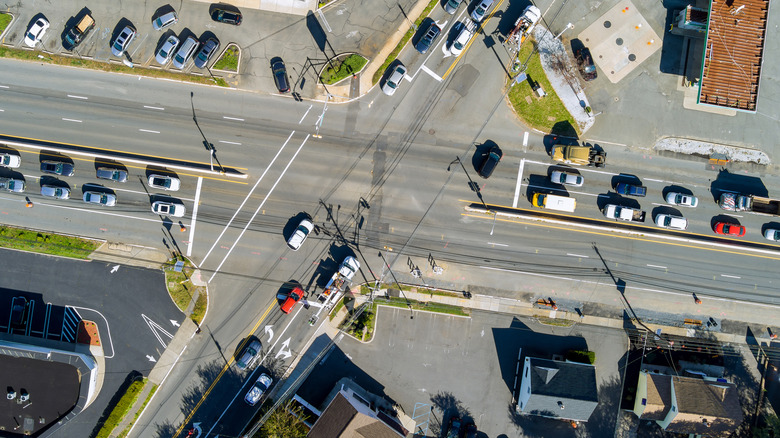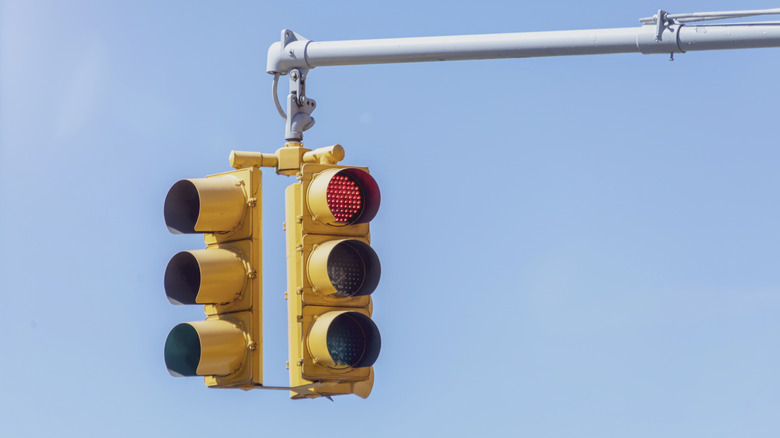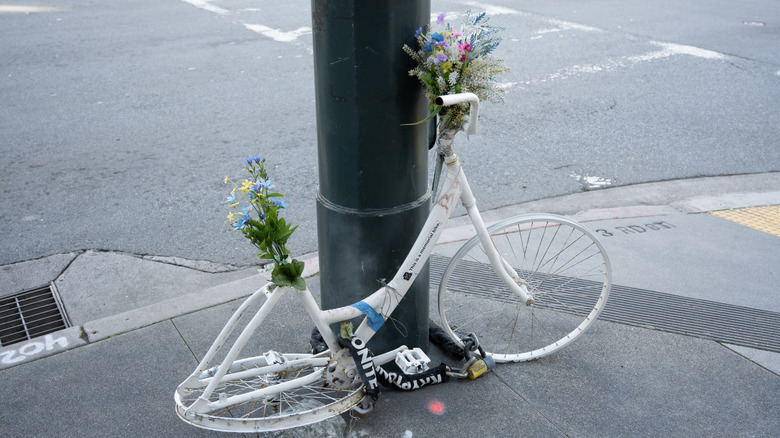This Is The Leading Cause Of Fatal Intersection Accidents
America's intersections are a frequent site of death, marking them as one of the most hazardous elements of an average roadway. In 2022, the United States Department of Transportation recorded 42,514 lives lost on U.S. roadways. According to the Federal Highway Administration (FHWA), 12,036 took place at an intersection, a nearly 30 percent rate. There are states with more dangerous roads than others, of course, but crossings remain uniquely hazardous. What is going on?
With multiple lanes of traffic headed in different directions, intersections are inherently complex. Vehicles, pedestrians, and cyclists must share the road, and unique considerations must be taken for each when implementing safety measures at a crossroads. Distracted, tired, or impaired drivers pose a danger on all roadways, but they become especially dangerous at an intersection, where they often zip through without checking for oncoming traffic, ensuring their right of way, or looking for pedestrians. But even so, one factor consistently makes certain intersections more dangerous than others.
When looking at the high number of accidents and fatalities related to intersections, the one factor that determines how many lives will be ended at a junction is whether it has a traffic signal. Other safety measures, such as designing roads to slow drivers down as they approach a crossroad, improving sightlines, and adding roundabouts, can also increase safety. It's also a good idea to follow some driving safety tips. However, the most lifesaving feature of an intersection appears to be a simple stoplight. So, here's how the numbers shake out and what can be done to make intersections safer for everyone.
A lack of traffic signals make intersections more lethal according to data
According to FHWA data collected from 2018 to 2022, a lack of traffic signals is the leading cause of car-related deaths at or around intersections. In total, there were 54,976 traffic fatalities involving an intersection during those years. 36,505 of those fatalities took place at an "unsignalized" intersection, which is defined as any intersection that has no signals (also known as traffic lights). In addition to intersections without any signage, even intersections governed by stop or yield signs are considered unsignalized. 9,226, or nearly 17 percent of intersection-related deaths were pedestrians, 4,933 of whom died at unsignalized intersections. In signalized intersections, by contrast, 18,471 fatalities took place over the same five-year time span.
Adding traffic signals to an intersection clearly makes it far safer for all, but implementing them in certain ways can take things a step further. Thanks to the data driving the future of car safety, we know that adjusting the timing of lights to give pedestrians a green crossing signal five to seven seconds before the light turns green for cars — also known as a leading timing signal — has been shown to reduce pedestrian-vehicle crashes at intersections by as much as 13 percent. Pedestrian hybrid beacons, which involve putting special traffic lights at non-intersection pedestrian crossings, may decrease pedestrian crashes by up to 55 percent by moving those on foot away from high-volume intersections. These measures could help reduce car-to-car collisions in intersections, too. The fewer pedestrians and cyclists are in the intersection when cars pass through, the more drivers can focus on the car traffic around them.
The US has deadlier intersections than other counties, especially for pedestrians
Thanks to an increased focus on safety, car-related deaths plummeted across the world for decades. The United States seemed to be keeping pace. Then, the trend reversed. As car-related deaths stalled out in Europe, Australia, and parts of Asia, Americans found themselves increasingly likely to be killed by a vehicle. Pedestrian deaths in the United States rose by 50 percent in the 2010s, making up much of the excess mortality rate on American roads. In research from the European Commission, those on foot make up about 20 percent of traffic fatalities. In the United States, that figure has rose to 36 percent as of 2022, according to a report from advocacy group Dangerous by Design. This American exceptionalism holds true for intersection-related fatalities. Though they account for roughly 30 percent of car-related deaths in the United States, they make up only about 21 percent in the European Union. What can we learn from those countries to save lives in the U.S.?
Many areas of Europe have made roads safer for both pedestrians and drivers by implementing some simple yet ingenious traffic calming strategies on roadways. Places such as the Netherlands implement narrowed lanes buffered by trees on either side, forcing drivers to navigate more carefully, raised crosswalks that subconsciously make pedestrians the priority at an intersection, and S-shaped road curves known as chicanes, which force drivers to slow down instead of approaching an intersection at full speed. In combination with installing well-timed traffic signals as described earlier on, it is possible to drastically improve the safety of intersections for everyone who passes through them.


